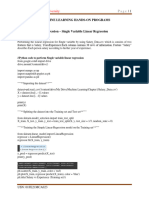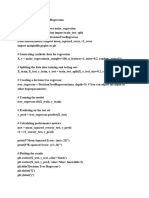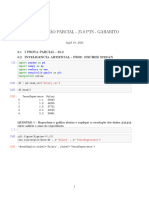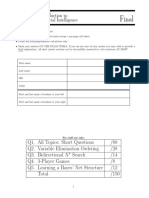.
# Logistic Regression
# Importing the libraries
import numpy as np
import matplotlib.pyplot as plt
import pandas as pd
# Importing the dataset
dataset = pd.read_csv('Social_Network_Ads.csv')
X = dataset.iloc[:, :-1].values
y = dataset.iloc[:, -1].values
# Splitting the dataset into the Training set and Test set
from sklearn.model_selection import train_test_split
X_train, X_test, y_train, y_test = train_test_split(X, y, test_size = 0.25,
random_state = 0) print(X_train)
print(y_train)
print(X_test)
print(y_test)
# Feature Scaling
from sklearn.preprocessing import StandardScaler
sc = StandardScaler()
X_train = sc.fit_transform(X_train)
X_test = sc.transform(X_test)
print(X_train)
print(X_test)
# Training the Logistic Regression model on the Training set
from sklearn.linear_model import LogisticRegression classifier =
LogisticRegression(random_state = 0)
cf=classifier.fit(X_train, y_train)
cf.intercept_
cf.coef_
cf.predict_proba(X)
cf.score(X,y)
�# Predicting a new result
print(classifier.predict(sc.transform([[30,87000]])))
# Predicting the Test set results
y_pred = classifier.predict(X_test)
print(np.concatenate((y_pred.reshape(len(y_pred),1),
y_test.reshape(len(y_test),1)),1))
# Making the Confusion Matrix
from sklearn.metrics import confusion_matrix, accuracy_score cm =
confusion_matrix(y_test, y_pred)
print(cm)
accuracy_score(y_test, y_pred)
# Visualising the Training set results
from matplotlib.colors import ListedColormap
X_set, y_set = sc.inverse_transform(X_train), y_train
X1, X2 = np.meshgrid(np.arange(start = X_set[:, 0].min() - 10, stop =
X_set[:, 0].max() + 10, step = 0.25), np.arange(start = X_set[:, 1].min() -
1000, stop = X_set[:, 1].max() + 1000, step = 0.25))
plt.contourf(X1, X2, classifier.predict(sc.transform(np.array([X1.ravel(),
X2.ravel()]).T)).reshape(X1.shape),
alpha = 0.75, cmap = ListedColormap(('red', 'green')))
plt.xlim(X1.min(), X1.max())
plt.ylim(X2.min(), X2.max())for i, j in enumerate(np.unique(y_set)):
plt.scatter(X_set[y_set == j, 0], X_set[y_set == j, 1], c =
ListedColormap(('red', 'green'))(i), label = j) plt.title('Logistic Regression
(Training set)')
plt.xlabel('Age')
plt.ylabel('Estimated Salary')
plt.legend()
plt.show()
# Visualising the Test set results
from matplotlib.colors import ListedColormap
X_set, y_set = sc.inverse_transform(X_test), y_test
�X1, X2 = np.meshgrid(np.arange(start = X_set[:, 0].min() - 10, stop =
X_set[:, 0].max() + 10, step = 0.25), np.arange(start = X_set[:, 1].min() -
1000, stop = X_set[:, 1].max() + 1000, step = 0.25))
plt.contourf(X1, X2, classifier.predict(sc.transform(np.array([X1.ravel(),
X2.ravel()]).T)).reshape(X1.shape),
alpha = 0.75, cmap = ListedColormap(('red', 'green')))
plt.xlim(X1.min(), X1.max())
plt.ylim(X2.min(), X2.max())
for i, j in enumerate(np.unique(y_set)):
plt.scatter(X_set[y_set == j, 0], X_set[y_set == j, 1], c =
ListedColormap(('red', 'green'))(i), label = j) plt.title('Logistic Regression
(Test set)')
plt.xlabel('Age')
plt.ylabel('Estimated Salary')
plt.legend()
plt.show()























































































